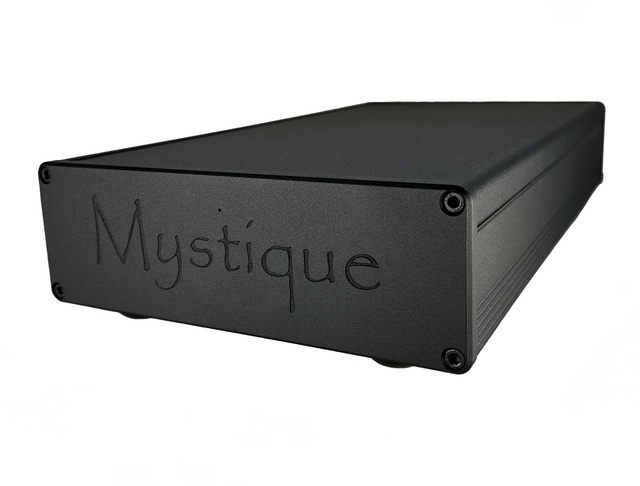Mojo Audio Mystique Y-NC DAC
A "bit" Closer to Music
Just because Tracking Angle unapologetically advocates for analog-based audio doesn’t mean we are digital troglodytes. I am confident that many professed analog lovers out there are "closet streamers," so staying updated on the fast-changing developments in the digital arena is important. Combining analog musical satisfaction with digital music's convenience and accessibility is a lofty but worthwhile goal. But don’t fret; this is not an announcement that I have gone to the digital dark side, nor have I found that elusive solution. I simply want to share a brief review of a Digital-to-Analog Converter (DAC) brand that has enhanced my digital listening experience and how it impacted my perspective on vinyl versus digital listening.
In 1983 at the Summer Chicago CES show I experienced my first Compact Disc , and it became clear to me that the music reproduction industry was about to face significant challenges. Almost immediately, various methods such as upsampling, oversampling, single bit, sliding bit, FGPA, and others were attempted to improve CD reproduction. While some of these were more successful than others, none truly did justice to the music. Two and a half years ago, I had the opportunity to review the Mojo Mystique X SE DAC, and I was impressed by its ability to render the lands and pits with what I described as a sense of "Digital Calm," a term I never thought I would use when discussing a DAC. Until then, I had only imagined using such a term alongside other oxymorons like "silent noise," "jumbo shrimp," "exact estimate," and one of my favorites, "original copy."
In that review, I concluded:
"The Mojo Mystique X SE DAC allowed me to use the least amount of "mental error correction" I have had to apply when listening to a digital source. This, in turn, meant that I could relax and listen to music, something I regularly experience with analog but less often with Digital."
At the time, the Mystique X SE rang the register at 10K.
Benjamin Zwickel Mojo Audio designer and owner contacted me earlier this year with news that he would be offering a USB-only version of the Mystique X SE DAC architecture starting at $3999.00, offering similar sound quality at less than half the price. I was intrigued.
When I asked Benjamin what instigated the development of the new Mystique Y DAC, he responded:
"Since over 80% of our customers exclusively use computer audio, we developed a version of our Mystique DAC optimized for USB. Nearly identical to our award-winning Mystique X in circuit, power supplies, component parts, and chassis, the Mystique Y delivers all the Mojo at half the price.
Because the Mystique Y has only one USB input we were able to greatly simplify the digital circuitry. No need for an input selector, demultiplexer, or S/PDIF receiver. The AD1865 R-2R DAC chip is directly fed by the USB input module."
The Mystique Y (starting at $3999.00) and Mystique X (starting at $6999.00) are essentially the same, except for the multiple inputs and the use of a 20-bit DAC chip in the Mystique X compared to the 18-bit chip in the Mystique Y. You can find a comparison chart of the two here.
The sonic differences between the two chips are subtle but noticeable. The 18-bit chip sounds energetic and exciting, while the 20-bit chip sounds more harmonically dense and liquid. Both units have excellent flow and timing that sets them apart from many other DACs. A choice between the two may come down to the important consideration of system synergy.
All Choked Up
Ladder DAC technology and choke-based power supplies form the foundation of Mojo Audio's design philosophy. Benjamin believes a Choke/ Capacitor (LC) filtered power supply yields the best "time and tune" and the most articulate attack/sustain/decay. I asked him to explain:
“Most power supplies used in solid-state electronics only use capacitors.
Capacitors store voltage. It makes no difference if they are Black Gate caps, Super caps, or capacitors reverse engineered from alien technology. The physics remains the same.
Voltage is the width of the river and current is the speed the water is flowing.
This means that the more energy required to reproduce a note, such as a belting midrange or a booming bass note, the more off-time and off-tune it will be if your power supply only uses capacitors.
Chokes store current.
By combining chokes with capacitors in a power supply, you get instantaneous and effortless power. The time and tune of every note is correct. The harmonics align correctly from the lowest lows to the highest highs.”
As for his insistence on using an R-2R DAC chip, he explains:
“An R-2R ladder DAC decodes a digital signal, while a Delta Sigma DAC interpolates rather than decodes the music. They take in the bit stream faster than the music is playing, analyze it for inconsistencies, and "correct" it using statistical error correction algorithms. They then export a flawless interpolated waveform.”
If you would like to explore Ben's thinking, he has written several "White Papers" that are good reading for those who want to delve deeper into these two subjects that to investigate technically rise above my pay grade.
Climbing the Ladder
Regarding DACs, I prefer R-2R ladder DACs. I haven't yet found a Delta Sigma DAC that can keep my attention for more than 30 minutes without making me feel restless. Drawing from my background in photography, I liken the difference between an R-2R DAC and a Delta Sigma DAC to my preference for film over digital photography.
While digital photography offers ultimate precision and easy manipulation, to my eyes film still provides a unique richness in tones and gradations. It has a character about it that is … well … “filmlike.” Similarly, a Delta Sigma DAC reveals more information, whereas an R-2R-based DAC offers deeper insight and understanding of the artist or instrument. It has a character that is … well … more “analoglike.”
I recognize that these are broad generalizations about the two DAC architectures, and exceptions surely exist in the audio landscape. Still, it is important for the reader to understand a reviewer's bias in the context of the review.
The Mystique Y-NC
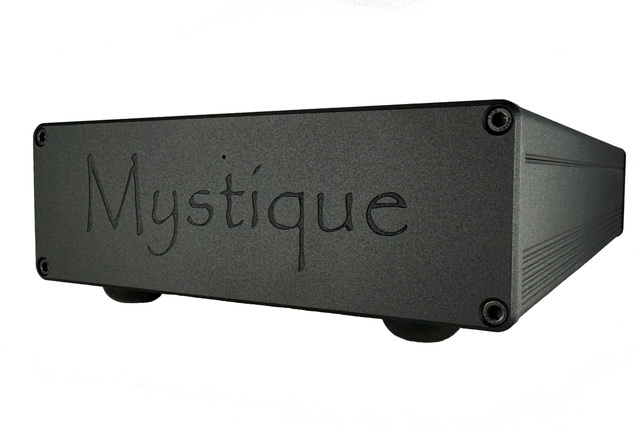
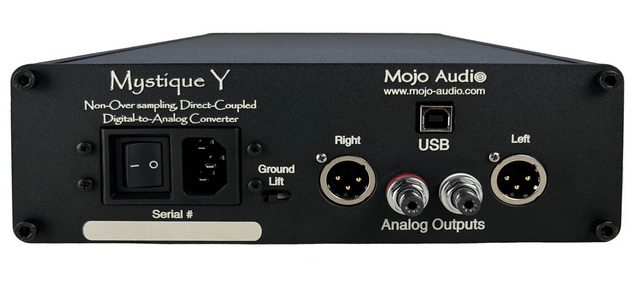
The Mystique Y weighs 15 pounds and is housed in a half-wide chassis that measures 9″W x 3″H x 16″D. The front panel features one discrete blue power light above the logo.
On the rear panel, we find the USB input. It uses a high-performance XMOS receiver chip, is galvanically isolated, asynchronous, and has ultra-low noise femto clocking. To completely isolate the digital and analog power supplies, the USB input module has its own secondary on the power transformer and its own Silicon Carbide zero-recovery Schottky diode rectification. It uses two Belleson SPX ultralow-noise ultra-high-dynamic discrete regulators, one for input and one for output.
Below the USB input are the single-ended RCA (2.3V peak-to-peak) and XLR balanced (4.6v peak-to-peak) analog outputs—the manual contains this interesting note about which is preferred.
"Most people find single-ended amplification to have better time, timbre, and musical flow. Most people find balanced amplification to have more gestalt and intensity at the expense of musical flow. Most people find the same is true with our DACs. Many of our customers who have balanced inputs on their amps prefer the single-ended outputs from our Mystique DACs feeding the single-ended inputs on their amps. We recommend comparing the balanced and single-ended outputs on our DACs on your amp in your system before deciding which to use. We do not recommend assuming which will sound better based on theory, statistical preferences, or the advice of other people."
That is great advice.
To the left of the analog outputs, we find the AC input and power switch, recommended to be left on 24/7, and a switch labeled "ground lift."
This micro slide switch lifts and disconnects the DC ground from the AC, chassis, and Earth grounds. The DAC is shipped with the ground lifted, and it is recommended to stay that way unless you experience some ground-related noise.
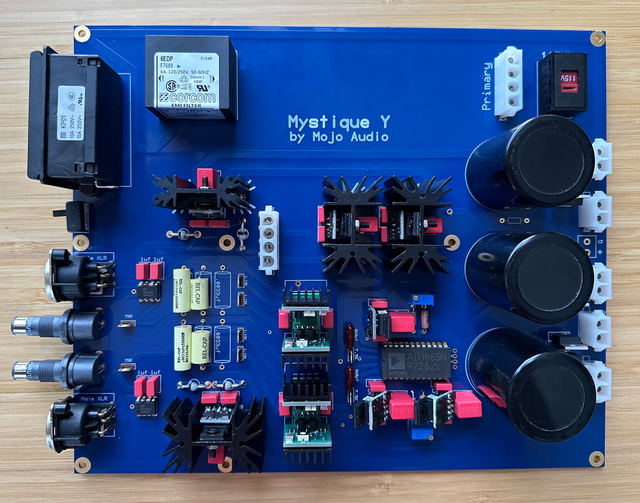
The signal board above shows the use of top-quality parts, including Mundorf Capacitors, naked Vishay resistors, seven Belleson ultra-low noise regulators, Furutech low-mass RCA connectors, Lundahl chokes, and more.
The primary circuit design is non-oversampling direct-coupled R-2R with no pre-digital filtering, digital noise shaping, upsampling, oversampling, or error correction algorithms.
The analog output stage is direct-coupled, eliminating output coupling capacitors or transformers. For the analog output it features Staccato Class A discrete op amps.
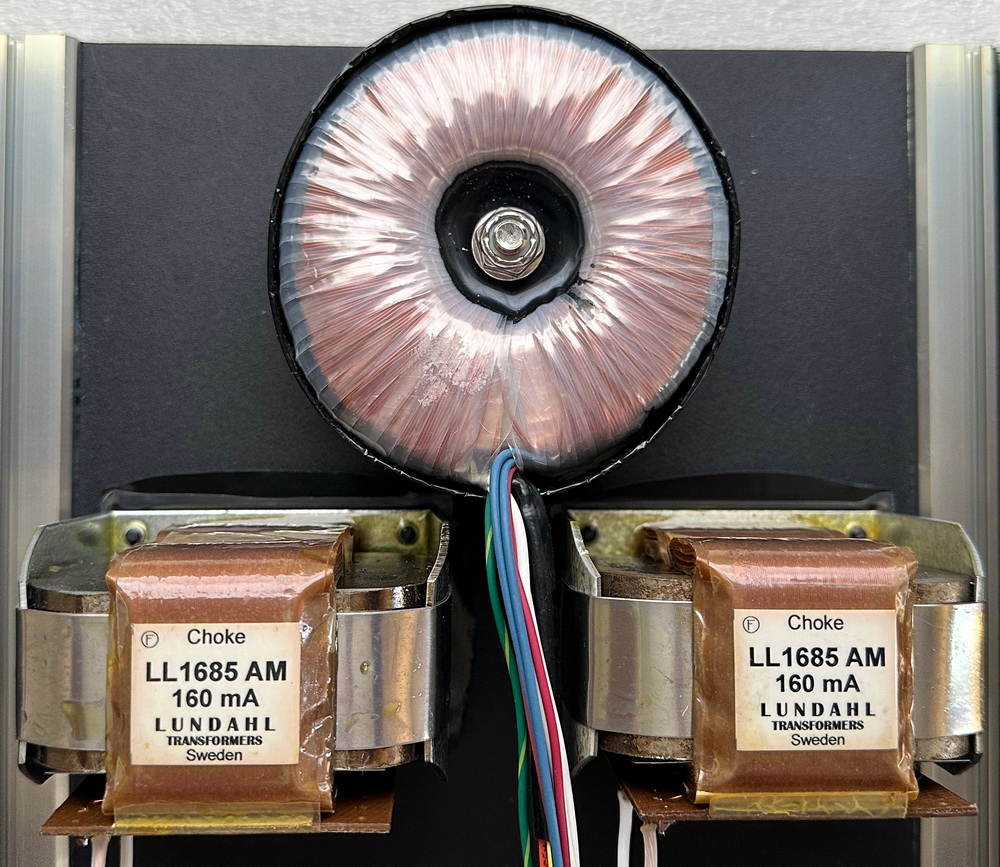
The standard Mystique Y' power supply uses ferrous core (Fe) chokes. You can opt for two other choke upgrades: the Amorphous Core (AM) version, which costs $5499.00, or the Nano Crystal (NC) version used in this review, which costs $6999.00.
Since I did not have all three versions in-house, I asked Ben for his thoughts on the impact of the different metallurgy used in the chokes.
“With different types of chokes you get more micro details and micro dynamics. The total energy remains the same but resolution is improved.
With our ferrous core chokes picture a sine wave with tiny bumps all over the surface.
With our amorphous core chokes picture a slightly lower sine wave with tiny star bursts of energy all over the surface.
With our nano crystal core chokes picture an even lower sine wave with huge star bursts of energy all over the surface.
Each sine wave has an identical amount of area and an identical amount of energy. It is just that with the more advanced core materials the energy is a bit diffused into deeper textures which are less noticeable with the more common ferrous cores. Sonically you get more gestalt and slam with the ferrous core and you get less slam, more nuances, more pronounced textures, and more emotional content, with the more advanced core materials."
Listening
During the audition period, the signal chain was:
Innuos Zenith MKIII USB > Mystique Y-NC > VAC Master Preamp > SMc GT 21 DNA 0.5 monoblocks > Acora SRC 2 / REL S/510 six-pack.
Installing three Stillpoint Ultra 2s under the Mojo DAC added a dynamic jump factor that appealed to me.
Rather than break down this component's sound into specific areas, I think it is more important to relate, in a global sense, how the unit impacted me in the context of my affinity for vinyl. I could talk about soundstage, depth, harmonic structure, analog-like macro/micro dynamics, timbre accuracy, oneness, midrange, treble, blah blah blah, and yes, it would be deserving of praise on all these accounts and more. But you have read all of that before in reviews of other DACs, and it would just come across as the newest member of the infamous DAC-of-the-Month Club, which would not be fair to the Mystique Y-NC DAC.
This digital component represents more than that. It has a calmness, listenability, and musical engagement that I have not previously heard in digital reproduction but regularly experience when listening to my analog front end. On top of that, it has a large helping of the "musical flow" I get from vinyl, often referred to as PRaT (Pace, Rhythm, and Timing)—something that has eluded virtually every DAC I have heard to date.
This is Your Brain on Music
I appreciate the way vinyl reproduces music, flaws and all. It triggers a certain emotional response in my brain, similar to the feeling I get when listening to live acoustic music. Vinyl has a calming effect on me and taps into my emotional side. On the other hand, digital music engages my analytical side, making me focus on individual parts rather than the overall experience, which can be distracting. I'm searching for the same emotional response in digital sources I get from vinyl. Daniel Levitin's book "This Is Your Brain on Music" delves into how your brain is affected by music and is a very worthwhile read.
Why bring this up?
I enjoyed the Mojo Audio DACs that I tested. They didn't tire me out or make me feel unsettled when I listened to music on them. They recreated a portion of the same pleasurable impact that vinyl gives me.
For example, when I listen to Claire Martin's version of “I Wish I’d Met You” on vinyl, her touching vocals and the beautifully timed simple piano and bass accompaniment in the song move me. I've listened to this song on several DACs, but rarely achieved the same emotional connection. I have always attributed the failure to move me to streaming's limitations. When I streamed the song through the Mojo Mystique Y-NC, I felt like I was, at the very least, in the same emotional zipcode as when listening to the vinyl version. It is one of the very few DACs I have heard that can do this for me.
Eyes Wide Shut
Over 15 years ago, I wrote an article asking: "Do you listen with your eyes?" The article, titled "Eyes Wide Shut," delved into the phenomenon of experiencing music more authentically when listening with closed eyes. I have always believed that when you close off one of your senses, your other senses become more acute. You can focus on the sound by minimizing visual distractions and fully immersing yourself in the music. Essentially, closing your eyes can enhance your ability to hear, much like individuals who are blind rely on their heightened remaining senses to compensate for their lack of vision. I have revised my viewpoint on this matter to incorporate another rationale. We close our eyes not to hear better but to enable our brains to fill in the gaps. It's a kind of "mental error correction system."
I have found that when I close my eyes, I can convince myself that the instruments and performers are in the room. My mind fills in the missing cues, making me believe I'm hearing a real instrument or performer. Keeping my eyes closed is essential, as opening them would shatter the illusion. However, with the Mojo DAC, there were moments when the music sounded real enough for me to picture the instrument or vocalist in front of me with my eyes open.
It's quite unsettling to stare at a spot and have my eyes tell me that nothing is there while my ears are saying something different. I experience this more often with vinyl reproduction than with digitally sourced music.
Conclusion
Just like vintage wooden roller coasters offer something unique to the ride experience that newer metal rail coasters can't convey, this "old school technology" R-2R DAC takes me to a musical place that new-fangled DACs haven't been able to.
Make no mistake: I'm a fan of analog technology at heart and my search for a digital setup that can provide me with the same level of enjoyment and relaxation that I experience with my analog setup continues. The Mojo Audio DACs have moved me closer to that place and now occupy a shelf in my reference system.
You won't find any unobtainium used in this piece, no magic wire, and no whale oil-impregnated capacitors. Instead, this device was created through the refinement and rethinking of decades of design experience, combined with engineering knowledge and a passion for music.
As an analog lover and digital user, here's my takeaway. If you've been on unfulfilling rides on the DAC merry-go-round in search of a digital component that will immerse you more in your music and less in your equipment, one of the Mojo Audio DACs may be a ride you want to buy a ticket for.
Price as tested $6999.00
Specifications
Mystique Y-NC DAC
· Built around Analog Devices' legendary 18-bit AD1865 R-2R ladder DAC chip.
· Converts PCM format files up to 24-bit 192KHz.
· Galvanically isolated independently powered XMOS USB input module.
· Incredibly accurate ultralow-noise femto clocking.
· Direct-coupled ultrahigh-performance Staccato class A discrete op amps.
· Vishay TX2575 "Naked" resistors matched to 0.1% in analog signal path.
· No output transformers or coupling caps to narrow bandwidth or distort phase.
· Independent circuits optimize linearity at the MSB zero voltage crossing.
· LC choke input analog power supplies with custom Lundahl chokes.
· Optional Upgrade: Lundahl amorphous core analog PSU chokes.
· Optional Upgrade: Lundahl nano crystal core analog PSU chokes.
· Ultra-fast ultralow-noise zero recovery SiC Schottky rectification diodes.
· 3 independent power supplies with 15,000uf Mundorf 4-pole capacitors.
· 7 Belleson SPX ultralow-noise regulators isolate IC chips, modules, and clocks.
· Cryo'd Kimber VSS VariStrand wire between main PSU and USB input module.
· Rel-Cap Polystyrene film and tin foil capacitors in the anti-aliasing filters.
· Furutech rhodium plated low mass RCA connectors directly soldered to PCB.
· Neutrik gold plated male and female XLR connectors directly soldered to PCB.
· Schurter AC input module and medical grade advanced AC input filtering.
· Ground lift switch isolates DC ground from Earth, chassis, and AC grounds.
· Optional 3-point Sorbothane domed anti-resonance footers.
· Low-resonance high-rigidity extruded aluminum chassis.
· Field convertible from 110VAC to 250VAC both 50Hz and 60Hz.
· 9"W x 3"H x 16"D and 15 pounds.
Manufacturer Information
2616 Muriel St NE, Unit A
Albuquerque, New Mexico 87112
United States of America
info@mojo-audio.com
(949.438.6656)


